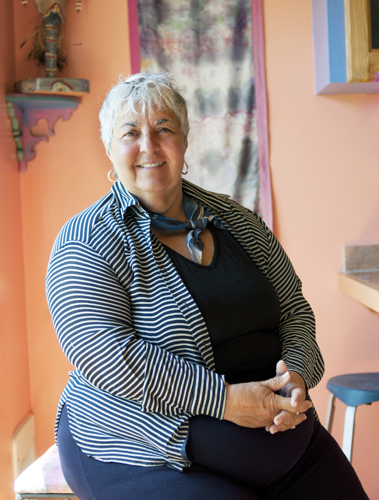
Renowned Sebastian silk artist Rita Bernstein’s sumptuous works are enjoyed and displayed in homes, synagogues, churches, universities, museums and galleries across the country, from Villanova to Temple, Telluride to Bal Harbor, Tucson to Cambridge, Ashville to St. Augustine.
Born in Philadelphia, Bernstein has been fascinated by silk virtually all her life. Her grandfather, a Master Tailor and Talmudic scholar, immigrated to Pennsylvania from Hungary in the late 1900s. He established the family business, designing and manufacturing silk lampshades, which would endure for almost half a century.
From the age of 2, young Rita loved to spend time in the factory, watching the process, learning how the machines worked, going through “the great pantries filled with bolt upon bolt of silk, mostly whites or pastels,” cutting the patterns. She loved watching the metal being welded into various shapes, the skeletons for her grandpop’s elegant shade designs.
As an adolescent, Bernstein came across a “recipe” for batik in a ladies’ magazine. Intrigued, she decided to give it a go. “I went down and got some silk scraps from the factory.” With candle wax and India ink, she created her first batik piece. She was not quite 14.
From then on, Bernstein’s interest and skill continued to grow so that, by the time she got to college (the University of Pennsylvania in Philadelphia), “I was already somewhat accomplished.” In spite of her love of silk, Bernstein earned her Master’s Degree in sculpture.
“Back then most people didn’t wear or have silk. It was only for the wealthy. But I was fascinated. I started a library, studied the silk worm.”
Silkworms, the offspring of moths, only eat mulberry leaves, wet with morning dew or rain, she explains. When the “miniature, mulberry leaf-munching marvel” is totally stuffed with mulberry leaves, it oozes a silky fiber out of a teeny hole in its jaw, and a gooey, gluey substance out another, to hold the fibers together, creating fine threads, which it then spins into a cocoon around itself, from “miles and miles of fibers.”
In only about 72 hours, the worm can produce 500-1,200 silken threads. When the worm has matured inside the cocoon, it cuts itself out, having morphed into a butterfly.
But not always. In the silk industry, Bernstein continues, the silk-bearing cocoons are boiled to extract the precious fiber, thus curtailing the cycle of life for those particular silkworms. These days silk in large quantities is only produced in China and India, where there is an abundance of cheap labor.
“Most of mine comes from remnants and ends of lots,” she says. “I realized early on that this is what I was interested in doing. I’ve dyed thousands of pieces.”
Bernstein, who is Jewish, developed a friendship and a long-time collaboration with the Rev. Richard Cannuli, an Augustinian priest and professor of fine arts and curator of the art collection at Villanova University.
Like Bernstein’s grandpop, Cannuli is a master tailor, and he commissioned her to create silk pieces which he fashioned into altar cloths, vestments and other liturgical items. Soon Bernstein began to construct prayer shawls, wedding canopies, delicate lingerie, pajamas and other apparel, as well as wall hangings and simple, beautiful lengths of silken fabric.
Over the years, silk dying has become part of her daily life, but a visit to her Sebastian home/studio/gallery makes it delightfully clear that Bernstein’s artistry and creativity cover an even broader spectrum.
Bernstein’s home, tucked away behind trees and bushes on a quiet street, contains racks of her luminous silk creations, scarves and shawls, loungewear, decorative runners and hangings, myriads of colors flowing across the diaphanous fabrics. From the ceiling hang silken cylinders. On the porch, bolts of hand-woven silk are heaped on a large worktable, some lengths dyed in the traditional striped style and colors – shades of blues and purples – of Jewish prayer shawls, a special commission she is in the midst of.
A large, two-piece, metal cylinder in the corner is, she explains, a steamer – industrial strength. When the fabric has received the dye, it is wrapped around a cardboard tube and placed in the steamer to set the design.
Bold color is everywhere. The kitchen sings with raspberry, lime, yellow, orange, teal; the ceramic drawer and cabinet pulls have been painted by Bernstein, each a unique design. The fridge doors are disguised behind brightly painted wooden panels. On shelves sit dozens of small, crayon-box colorful creatures: cats, dogs, dragons, cupcakes, all examples of the clay sculpture Bernstein did for years, when she worked at Disney’s Wabasso Resort as an art teacher for the young guests.
In other areas, small, detailed religious icon paintings depict the specific, methodical, gold leaf style of early Christian, Jewish and Hindu artists. On a low table by the window and atop the piano, painted wooden forms dance and pose, each wearing its own bright fabric costume.
Bernstein has studied and performed Kirtan, a Hindi form of praise and worship, which involves chanting hymns to the accompaniment of instruments. For many years, Bernstein would transform into Ms. Rita Rabbit, entertaining children of all ages with her silly, kind, batty bunny persona, complete with huge flowered bonnet, heaps of eggs, paints, candy treats and clay figures.
Rita Rabbit brought love and laughter to children, the elderly, the disabled, until, after three decades, hanging up her bonnet.
From Cape May, to Greece, Israel to Colorado to Florida, Bernstein has sought and found inspiration for her art in the natural world. She finds everything in nature has its own story to tell and calls nature her greatest teacher. Inspiration and illumination have come as well from treasured friends and mentors. At the end of the day, Bernstein says, “The Beatles were right! Love is all there is.”



